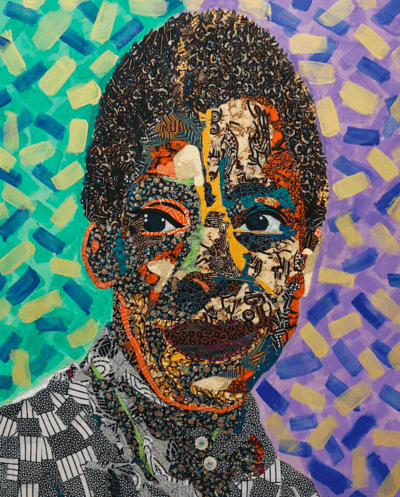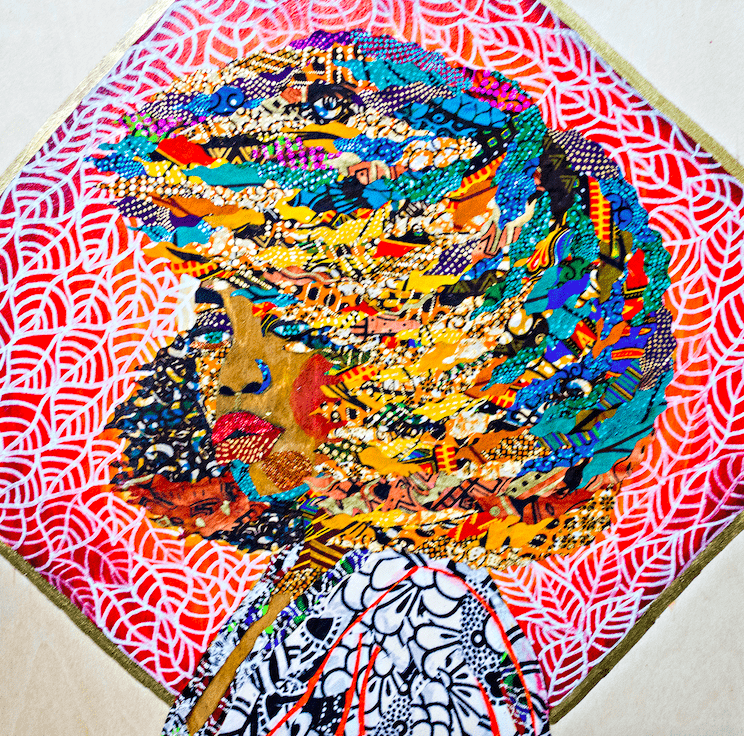In case you haven’t heard, we’re huge fans of Workman Arts. This Toronto-based organization celebrates the connection between visual art and those of us who are living with mental health issues and/or substance-use challenges. Their annual Being Scene exhibition is on now until March 23 and brings together 60+ artists to give a voice to our diverse life experiences. The programming is FREE, so don’t miss out!
We’re getting up-close and personal with some of the featured artists from Being Scene. For this instalment, we caught up with author, actor, multimedia artist and teacher Apanaki Temitayo M. Born in Toronto and raised in Trinidad and Tobago, her canvas compositions are an expression of her Trinidadian heritage and spirituality.
James Baldwin: The Fire Next Time, and Ti Amor: I Am Not My Hair are two of Apanaki’s incredible pieces that you’ll be able to check out at Being Scene.
SDTC: In short, what does art do for you?
SK: My art is literally therapy. It helps me transcend my trauma and gives me space to be unapologetically myself. It reaffirms parts of who I am as a Caribbean woman from the diaspora.
What is it about the Being Scene show that excites you most?
Being Scene is more than a show to members of Workman Arts, it is a platform to reinvent yourself as an artist. I came to WA as a writer and poet over eight years ago, and because of Being Scene Juried Exhibition, I got a chance to submit creative work that wasn’t in my particular genre, and in so I doing added to a new discipline as an artist. It gave me a chance to explore being visual artist in my work at Being Scene 2012 and I was fortunate that my piece “The Egungun” got in.
When do you feel your most creatively inspired?
I would say any time my kids aren’t home, lol. I think I do my best work at night, when my kids are asleep and I get to focus my energies on my work.
You communicate aspects of your Trinidadian heritage through your work: how has this shaped your perspective?
I am very aware of myself firstly as women of the diaspora in the arts and what that means to be a visible, intersectional woman of Trinidadian heritage. Every piece of artwork calls me home and reminds me of the colour, vibrancy and melting pot that is my home country. The feel of the African fabric in my hands while I place them on the canvas reaffirms the legacy and history of myself as a Trinbagonian.
When is your favourite time to make art? Paint a picture for us.
My art is definitely a reflection of my state of mind. I wish I could say that my best pieces have actually come from a calm and safe space, but I tend to create my best work in a kind of mental chaos, where my art becomes the therapy. I usually get inspiration from images that I find either in my everyday life or the internet that speak to me. Once I get an image or idea in my head, it usually develops there. I work out a lot of my direction, rendering concepts of my work there first, and then when I finally get to the canvas it is like I have a picture of a puzzle that I get to put together, one piece of fabric at a time.

Apanaki, Ti Amor – “James Baldwin: The Fire Next Time”
Art aside, what in life are you really enjoying right now?
I am currently in the Centre for Addiction and Mental Health’s First Artist-in-Wellness working with staff and patients in using art to support and encourage mental wellness. It gives me great joy to be an Art Facilitator with Workman Arts through the Art Cart Program at CAMH and affect positive change in the wards.
I have also had the opportunity to work with the Textile Museum of Canada, Community Outreach Program and the Barbra Schlifer Commemorative Clinic to facilitate workshops that impact women in trauma. I am truly enjoying that my art practice is helping other people like myself, who struggle with mental health or trauma, find a place to be creative.
What mantra is currently helping you on your journey?
“Self-care is key to success.” It is something I struggle with, but I am finding new ways to incorporate this practice in everything I do creatively and also as a single mother. If I don’t take care of myself, then I cannot create. So from making sure I am properly rested at the end of a busy day or taking the time to do prep before workshops or just declining an offer until a more opportune time, or just spending much needed family time with my kids, falls under care of self. I try to find a work-home balance that works for me, and it has been helping me succeed as an artist.
Who or what really helped you become an artist?
Award-winning author and writer Dr. Althea Prince, who was then a professor at University of Toronto, was my first influencer when I was in the pilot project for the Transition Year Program. She was the first person to see me in my writing and that my works deserved to be published.
Coming back to the country of my birth that I knew nothing about was jarring. At that time my writing helped me deal with the culture shock and find my voice. Dr. Prince was instrumental in getting my first work published in an Anthology Literary Journal called P.H.O.T.I (phish) through the Toronto Arts Council, Fresh Arts Program. This helped me believe that my creative voice was valid and important; it helped me become the artist I am today.
Lastly, can you describe the work you will be showing at Being Scene?
In Being Scene 2019, I am currently showing three portraits. James Baldwin: The Fire Next Time is part of my Black Icon Series which is my life’s work. It celebrates his activism, his brilliance and his humanity. I want to explore Black and POC who inspire and influence my life in my work. Ibukun Ami: Blessed Mark celebrates reclaiming of beauty standards with the portrait of Kgothi Iman, a South African Model with vitiligo. Ti Amor: I Am Not My Hair, is a testament to black hair joy unapologetically.
The Workman Arts Being Scene exhibition is on now until March 23. This event is FREE! Check out Apanaki’s solo show on right now at Full of Beans Coffee House & Roastery (1348 Dundas St W).



 Follow Us On Instagram
Follow Us On Instagram
